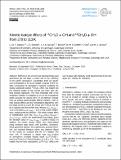| dc.contributor.author | Joelsson, L. M. T. | |
| dc.contributor.author | Schmidt, J. A. | |
| dc.contributor.author | Nilsson, E. J. K. | |
| dc.contributor.author | Blunier, T. | |
| dc.contributor.author | Griffith, D. W. T. | |
| dc.contributor.author | Johnson, M. S. | |
| dc.contributor.author | Ono, Shuhei | |
| dc.date.accessioned | 2018-03-23T19:08:02Z | |
| dc.date.available | 2018-03-23T19:08:02Z | |
| dc.date.issued | 2016-04 | |
| dc.date.submitted | 2016-03 | |
| dc.identifier.issn | 1680-7324 | |
| dc.identifier.uri | http://hdl.handle.net/1721.1/114274 | |
| dc.description.abstract | Methane is the second most important long-lived greenhouse gas and plays a central role in the chemistry of the Earth's atmosphere. Nonetheless there are significant uncertainties in its source budget. Analysis of the isotopic composition of atmospheric methane, including the doubly substituted species [superscript 13]CH[subscript 3]D, offers new insight into the methane budget as the sources and sinks have distinct isotopic signatures. The most important sink of atmospheric methane is oxidation by OH in the troposphere, which accounts for around 84% of all methane removal. Here we present experimentally derived methane+OH kinetic isotope effects and their temperature dependence over the range of 278 to 313K for CH[subscript 3]D and [superscript 13]CH[subscript 3]D; the latter is reported here for the first time. We find k[subscript CH[subscript 4]]/k[subscript CH[subscript 3]D]] Combining double low line 1.31 ± 0.01 and k[subscript CH[subscript 4]]/k[subscript 13[subscript CH[subscript 3] D]]] Combining double low line 1.34 ± 0.03 at room temperature, implying that the methane+OH kinetic isotope effect is multiplicative such that (kCH 4 /k 13 CH 4 )(kCH 4 /kCH 3 D) Combining double low line kCH 4 /k 13 CH 3 D, within the experimental uncertainty, given the literature value of k[subscript CH[subscript 4]]/k[subscript 13[subscript CH[subscript 4]]] Combining double low line 1.0039 ± 0.0002. In addition, the kinetic isotope effects were characterized using transition state theory with tunneling corrections. Good agreement between the experimental, quantum chemical, and available literature values was obtained. Based on the results we conclude that the OH reaction (the main sink of methane) at steady state can produce an atmospheric clumped isotope signal (δ([superscript 13]CH[subscript 3]D) Combining double low line ln([CH[subscript 4]][[superscript 13]CH[subscript 3]D]/[[superscript 13]CH[subscript 4]][CH[subscript 3]D])) of 0.02 ± 0.02. This implies that the bulk tropospheric δ([superscript 13]CH[subscript 3]D) reflects the source signal with relatively small adjustment due to the sink signal (i.e., mainly OH oxidation). | en_US |
| dc.publisher | Copernicus GmbH | en_US |
| dc.relation.isversionof | http://dx.doi.org/10.5194/ACP-16-4439-2016 | en_US |
| dc.rights | Attribution 3.0 Unported (CC BY 3.0) | en_US |
| dc.rights.uri | https://creativecommons.org/licenses/by/3.0/ | en_US |
| dc.source | Copernicus Publications | en_US |
| dc.title | Kinetic isotope effects of [superscript 12]CH[subscript 3]D + OH and [superscript13]CH[subscript 3]D + OH from 278 to 313 K | en_US |
| dc.type | Article | en_US |
| dc.identifier.citation | Joelsson, L. M. T., et al. “Kinetic Isotope Effects of [superscript 12]CH[subscript 3]D + OH and [superscript 13]CH[subscript 3]D + OH from 278 to 313 K.” Atmospheric Chemistry and Physics, vol. 16, no. 7, Apr. 2016, pp. 4439–49. © 2016 Authors | en_US |
| dc.contributor.department | Massachusetts Institute of Technology. Department of Earth, Atmospheric, and Planetary Sciences | en_US |
| dc.contributor.mitauthor | Ono, Shuhei | |
| dc.relation.journal | Atmospheric Chemistry and Physics | en_US |
| dc.eprint.version | Final published version | en_US |
| dc.type.uri | http://purl.org/eprint/type/JournalArticle | en_US |
| eprint.status | http://purl.org/eprint/status/PeerReviewed | en_US |
| dc.date.updated | 2018-02-16T17:26:47Z | |
| dspace.orderedauthors | Joelsson, L. M. T.; Schmidt, J. A.; Nilsson, E. J. K.; Blunier, T.; Griffith, D. W. T.; Ono, S.; Johnson, M. S. | en_US |
| dspace.embargo.terms | N | en_US |
| dc.identifier.orcid | https://orcid.org/0000-0002-1348-9584 | |
| mit.license | PUBLISHER_POLICY | en_US |
